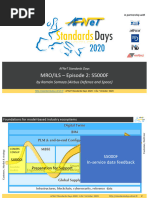What are the different MySQL database engines
Uploaded by
Indira pothirajWhat are the different MySQL database engines
Uploaded by
Indira pothirajWhat are the different MySQL database
engines ?
Database engines are MySQL components that can handle SQL
operations like create, read, update data from a database. There
are two types of engines in MySQL: transactional and non-
transactional.
InnoDB is the default engine for MySQL 5.5 and above versions.
Major DBMS uses an application programming interface(API) to
enable the interaction of users with database engines. It is very
necessary to know about the engines for production databases
and it also impacts future development. To access the list of
available MySQL engines we run SHOW ENGINES; query.
There are 2 types of database engines :
Transactional Databases: In this type, we can roll back the
write operations on the database if they are left incomplete.
These operations are known as transactions. Majorly, modern
engines are transactional.
Non-Transactional Databases: Unlike transactional
databases, they don’t provide Rollback/Commit. Instead, we
need to manually code to perform the rollback operations.
The below image illustrates the different available engines in
MySQL:
List of database engines in MySQL
In this article, we will learn about InnoDB, MyISAM, MEMORY,
MERGE, CSV, and SEQUENCE engines, their features, along with
knowing their advantages & disadvantages.
InnoDB: InnoDB is a storage engine for DBMS MySQL and
MariaDB.It is the default storage engine for MySQL versions 5.5
and higher. It replaced MyISAM as the default engine.
Features:
It provides standard ACID-compliant transaction features, along
with foreign key support. Oracle recommends InnoDB for
tables.
It supports multi-version concurrency control, crash-recovery,
and rollback operations. Multi-user performance is possible due
to row-level locking.
It is used in the MariaDB server too. To maintain data integrity
and security, InnoDB supports foreign key constraints.
InnoDB supports buffers that cache data as well as indexes.
It offers a table locking method, which means only one user
can alter the table at a time.
Advantages:
Supports ACID (Atomicity, Consistency, Isolation, and
Durability) properties for securing user’s data.
Access to multiple users with high performance and consistent
reads in Oracle-style.
Supports usage of foreign keys that help in the consistent
update, insert and delete operations. Also, it helps in
maintaining integrity in the contents of the tables of the
database.
Disadvantages:
Does not support full-text search.
If performance is a priority then it is not used because it is
slower than MyISAM.
Usage of foreign key relationships makes it complex to use.
MyISAM: It is the default engine for MySQL DBMS versions prior
to 5.5.MyISAM is a high-speed storage and retrieval storage
engine. It doesn’t support transactions. It is easy to copy between
systems and has a small data footprint. Mostly used in Web and
Data Warehousing.
Features:
MyISAM is stored in 3 files: .frm – Stores table format, .MYD –
Data files, .MYI – index file.
It supports three storage formats: Fixed, Dynamic, and
Compressed.
The maximum key length is 1000 bytes.
The maximum number of indexes per table and columns per
index are 64 and 16 respectively.
Advantages:
MyISAM is simpler than other engines.
It is faster than any other general-purpose database engine. It
also provides a full-text searching
Disadvantages:
It can easily lead to corruption of the table. However, we can
use the REPAIR TABLE query to recover it.
It does not support foreign key constraints or transactions.
CSV: It is used to store CSV format in a text file. It is always
compiled into the MySQL server. It is lightweight and can be
easily imported into spreadsheet programs.
Features:
CSV tables use CSV format.Thus, it can be used for data
exchange for eg. using the spreadsheet.
Editing data can be performed even if the MySQL server is
down using standard file editors
Instantaneous loading of massive data in the MySQL server.
Advantages:
Metafile is created that stores the state of the table and the
number of rows that exist in the table after creating the CSV
file.
Data is stored in a text file using the common-separated value
format.
Disadvantages:
CSV engine does not support indexing.
It does not support partitioning.
It must have NOT NULL attributes on all columns.
MERGE: Tables created using the MERGE engine are used to
handle a large volume of data easily. It is a collection of identical
MyISAM tables that can be used as one. Thus, it is also known as
the MRG_MyISAM engine. It is good for data warehousing
environments.
Features:
It was introduced in MySQL 3.23.25 version.
UNION and INSERT_METHOD are two unique features of MERGE
tables.
MERGE tables do not have PRIMARY KEY or UNIQUE indexes as
they cannot enforce uniqueness over all tables.
Advantages:
It is a collection of identical MyISAM tables that can be used as
one table. Memory is saved due to it.
It can perform the most efficient repair of individual tables
rather than repairing a single large table which is made by
merging these individual tables.
Merge tables are not limited to the file size of the operating
system, unlike MyISAM tables.
Disadvantages:
Only identical MyISAM tables can be used to merge.
If the MERGE table is nontemporary, it is necessary for merge
tables to be nontemporary. If the MERGE table is temporary,
the MyISAM tables can be a mixture of temporary and
nontemporary.
Some MyISAM features are not available in MERGE tables.
MEMORY: It is considered to be the fastest engine used to
usually create temporary tables in memory (also known as HEAP).
Thus data is lost when the database is restarted. It is non-
transactional. It is useful for quick looks up of references and
other identifying data. It stores all data in RAM for faster access
rather than storing data in disks. It is widely used for read-only
caches of data from tables or for temporary usage.
Features:
It does not create any files on disk.
MEMORY tables cannot contain BLOB or TEXT columns.
AUTO_INCREMENT columns are supported.
VARCHAR is stored using fixed-length i.e. it uses fixed-length
row-storage format.
Advantages:
Data is encrypted which is implemented in the server via
encryption functions.
Supports B-tree indexes.
Offers low-level locking and multiple-thread operation for low
contention between clients.
Disadvantages:
MEMORY tables cannot be partitioned.
Memory can’t be reclaimed if you delete individual rows from a
MEMORY table
SEQUENCE: It is the transactional engine used for creating
ascending or descending sequences of positive integers with
given initial, end, and increment values. It is read-only and
supports XA.
Features:
Like the MEMORY database engine, it does not create any file
on a disk.
It creates virtual tables automatically whenever we need them.
There is no way to create a SEQUENCE table explicitly.
This engine is useful with joins and subqueries.
Advantages:
SEQUENCE engine is not bound to tables. Thus, we can use
them for any other purpose too.
Flexibility in implementation of the table.
Disadvantages:
Additional programming is required for the AUTO_INCREMENT
feature which is not available in the engine by default.
Concurrency issue when there are multiple parallel sessions
active.
You might also like
- Ricoh Printer 3245C-Troubleshooting ManualNo ratings yetRicoh Printer 3245C-Troubleshooting Manual82 pages
- Mysql 5.1 Supported Storage Engines: Myisam MyisamNo ratings yetMysql 5.1 Supported Storage Engines: Myisam Myisam2 pages
- Mysql For Developers: Carol Mcdonald, Java ArchitectNo ratings yetMysql For Developers: Carol Mcdonald, Java Architect77 pages
- Postgresql Vs Mysql Vs Db2 Vs MSSQL Vs OracleNo ratings yetPostgresql Vs Mysql Vs Db2 Vs MSSQL Vs Oracle5 pages
- Advanced MySQL Administration and ProgrammingNo ratings yetAdvanced MySQL Administration and Programming35 pages
- MySQL 8 - Technical Specification August 2018No ratings yetMySQL 8 - Technical Specification August 20182 pages
- Data Warehousing With Mysql: Flat FilesNo ratings yetData Warehousing With Mysql: Flat Files15 pages
- Creating Database: Managing Databases in MysqlNo ratings yetCreating Database: Managing Databases in Mysql56 pages
- Lovely Professional University Phagwaa': Homework #I CAP304: Open Source TechnologyNo ratings yetLovely Professional University Phagwaa': Homework #I CAP304: Open Source Technology5 pages
- Boosting Performance and Scalability With The Innodb Upgrade For Mysql 5.1No ratings yetBoosting Performance and Scalability With The Innodb Upgrade For Mysql 5.111 pages
- P S T U: Atuakhali Cience AND Echnology NiversityNo ratings yetP S T U: Atuakhali Cience AND Echnology Niversity8 pages
- Mysql: Aaron Byers Sr. Sales Manager - Telecom & NetworkingNo ratings yetMysql: Aaron Byers Sr. Sales Manager - Telecom & Networking34 pages
- HR Multi 2 FAAC Remote Coding InstructionsNo ratings yetHR Multi 2 FAAC Remote Coding Instructions2 pages
- CSC222: Computer Organization: & Assembly LanguageNo ratings yetCSC222: Computer Organization: & Assembly Language23 pages
- Hacking: Don't Learn To Hack - Hack To LearnNo ratings yetHacking: Don't Learn To Hack - Hack To Learn19 pages
- Tender For Shifting of Office Esigned 1 9 MergedNo ratings yetTender For Shifting of Office Esigned 1 9 Merged10 pages
- 15 Top API Development Companies To Transform Your BusinessNo ratings yet15 Top API Development Companies To Transform Your Business12 pages
- SIFANG Smart Substation Solution - 12 04 201750% (2)SIFANG Smart Substation Solution - 12 04 201799 pages
- SP - ASD - 9.x Remote Lab Instructions For Self-Paced StudentsNo ratings yetSP - ASD - 9.x Remote Lab Instructions For Self-Paced Students11 pages
- SAP Note 1524325 - Poor Performance Due To Locks On Table NRIV - 1524325 - E - 20171028No ratings yetSAP Note 1524325 - Poor Performance Due To Locks On Table NRIV - 1524325 - E - 201710285 pages
- ASD2020 11a MroIls Episode2 RamonSomozaNo ratings yetASD2020 11a MroIls Episode2 RamonSomoza31 pages
- Etsi Gs Mec 003: Mobile Edge Computing (MEC) Framework and Reference ArchitectureNo ratings yetEtsi Gs Mec 003: Mobile Edge Computing (MEC) Framework and Reference Architecture18 pages
- TM-2120 AVEVA Marine (12.1) System Administration (Basic) Rev 5.0No ratings yetTM-2120 AVEVA Marine (12.1) System Administration (Basic) Rev 5.0151 pages
- Object Oriented Programming With Java Lab Exercises and Solutions63% (16)Object Oriented Programming With Java Lab Exercises and Solutions95 pages
- Implementing microsoft dynamics 365 for finance and operations implement methodology integration data migration and more Kasat instant download100% (2)Implementing microsoft dynamics 365 for finance and operations implement methodology integration data migration and more Kasat instant download57 pages






























































































